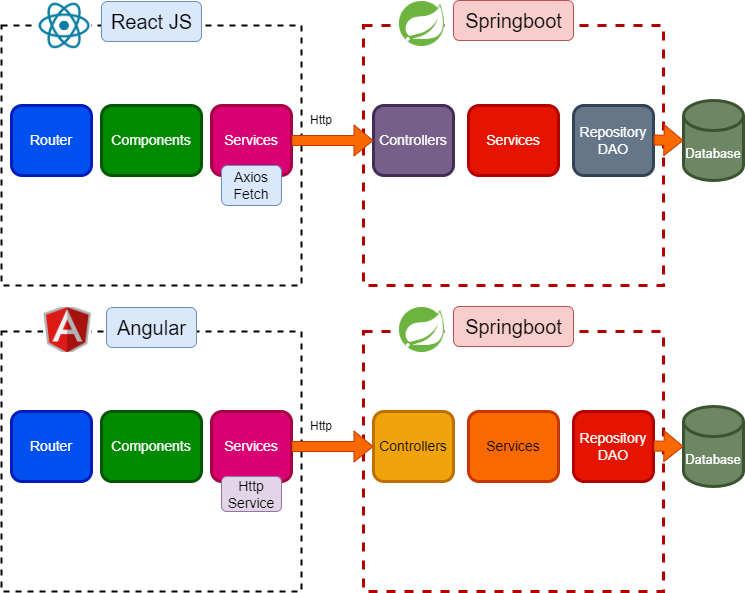Module 1: Frontend Development with ReactJS
-
Week 1: Introduction to ReactJS
- Overview of ReactJS and its features
-
Setting up the React development environment
-
Creating and running a simple React application
- JSX syntax
- Components, Props, and State
-
Week 2: Advanced ReactJS
- Lifecycle methods
- Handling events
- Conditional rendering
- Lists and keys
- Forms and controlled components
-
Week 3: State Management with Redux
- Introduction to Redux
- Setting up Redux in a React application
- Actions, Reducers, and Store
- Connecting React components to Redux
-
Middleware and asynchronous actions with Redux
Thunk
-
Week 4: React Router and Advanced Topics
- React Router for navigation
- Route parameters and nested routes
- Code splitting and lazy loading
- Testing React components
- Optimizing React applications
Module 2: Backend Development with Spring Boot
-
Week 5: Introduction to Spring Boot
- Overview of Spring Boot and its advantages
-
Setting up the Spring Boot development environment
- Creating a simple Spring Boot application
-
Understanding application.properties and YAML
configuration
- Spring Boot DevTools for development
-
Week 6: RESTful Web Services with Spring Boot
- Creating RESTful APIs with Spring Boot
- HTTP methods and status codes
- Request mapping and handling
- Path variables and request parameters
- ResponseEntity and exception handling
-
Week 7: Data Access with Spring Data JPA
- Introduction to Spring Data JPA
- Setting up JPA with Spring Boot
- Creating and managing entities
- Repository pattern
- Query methods and custom queries
-
Week 8: Spring Security
- Introduction to Spring Security
-
Setting up Spring Security in a Spring Boot
application
- Authentication and authorization
- Securing RESTful APIs
- Role-based access control
- JWT (JSON Web Token) for authentication
Module 3: Advanced Backend Development
-
Week 9: Spring Boot with MySQL
- Setting up a MySQL database
- Configuring Spring Boot to connect to MySQL
- CRUD operations with Spring Data JPA
-
Handling database migrations with Flyway or
Liquibase
-
Week 10: Spring Batch
- Introduction to Spring Batch
-
Setting up Spring Batch in a Spring Boot
application
- Creating batch jobs
- Chunk-oriented processing
- Managing job parameters and job execution
-
Week 11: Spring Boot Testing
- Unit testing with JUnit and Mockito
- Integration testing with Spring Boot
- Testing RESTful APIs with MockMvc
- Test containers for database testing
-
Week 12: Microservices with Spring Boot
- Introduction to microservices architecture
- Creating microservices with Spring Boot
-
Inter-service communication with REST and
messaging
- Service discovery with Eureka
- API Gateway with Spring Cloud Gateway
Module 4: Enterprise Web Project Development
-
Week 13-14: Project Planning and Design
- Requirement analysis and project planning
- Designing the application architecture
- Creating wireframes and UI/UX design
-
Setting up the project repository and initial
setup
-
Week 15: Capstone Project Development
- Requirement analysis and project planning
- Designing the application architecture
- Implementing core functionalities
-
Integrating frontend (ReactJS) and backend (Spring
Boot)
-
Implementing user authentication and authorization
- Handling form submissions and validations
- Testing and debugging
-
Week 16: Deployment and Cloud Hosting
- Introduction to cloud computing and AWS
- Setting up an AWS account
- Configuring NGINX for deployment
- Deploying the web application on AWS EC2
- Managing application logs and monitoring
-
Week 17: Review and Assessments
- Code reviews and feedback sessions
- Final assessments and quizzes
- Project showcase
-
Internship completion certificate distribution
Additional Activities:
- Weekly code reviews and feedback sessions
- Pair programming and group discussions
- Regular quizzes and assessments
-
Guest lectures and workshops on industry best
practices
Outcome:
By the end of this program, participants will have a
thorough understanding of ReactJS, JPA, Spring Boot,
Spring Security, Spring Batch, MySQL, and the ability to
develop and deploy an enterprise-level web project on
AWS Cloud using NGINX. They will gain hands-on
experience through real-world projects, preparing them
for a successful career as a Java Full Stack Developer.



